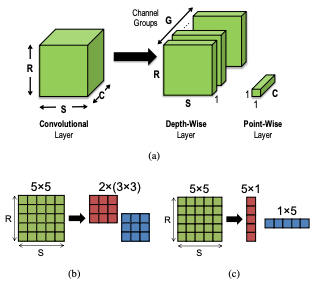
Yu-Hsin Chen, Tien-Ju Yang, Joel Emer, and Vivienne Sze
doi: arXiv:1807.07928
Abstract:
The design of DNNs has increasingly focused on reducing the computational complexity in addition to improving accuracy. While emerging DNNs tend to have fewer weights and operations, they also reduce the amount of data reuse with more widely varying layer shapes and sizes. This leads to a diverse set of DNNs, ranging from large ones with high reuse (e.g., AlexNet) to compact ones with high bandwidth requirements (e.g., MobileNet). However, many existing DNN processors depend on certain DNN properties, e.g., a large number of channels, to achieve high performance and energy efficiency and do not have sufficient flexibility to efficiently process a diverse set of DNNs. In this work, we present Eyexam, a performance analysis framework that quantitatively identifies the sources of performance loss in DNN processors. It highlights two architectural bottlenecks in many existing designs. First, their dataflows are not flexible enough to adapt to the varying layer shapes and sizes of different DNNs. Second, their network-on-chip (NoC) can’t adapt to support both high data reuse and high bandwidth scenarios. Based on this analysis, we present Eyeriss v2, a high-performance DNN accelerator that adapts to a wide range of DNNs. Eyeriss v2 has a new dataflow, called Row-Stationary Plus (RS+), that enables the spatial tiling of data from all dimensions to fully utilize the parallelism for high performance. To support RS+, it has a low-cost and scalable NoC design, called hierarchical mesh, that connects the high-bandwidth global buffer to the array of processing elements (PEs) in a two-level hierarchy. This enables high-bandwidth data delivery while still being able to harness any available data reuse. Compared with Eyeriss, Eyeriss v2 has a performance increase of 10.4x-17.9x for 256 PEs, 37.7x-71.5x for 1024 PEs, and 448.8x-1086.7x for 16384 PEs on DNNs with widely varying amounts of data reuse.
